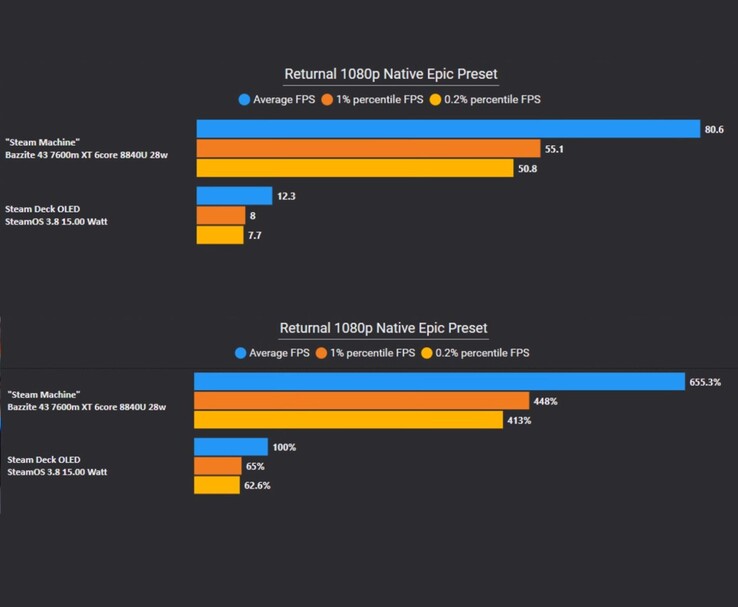YouTuber tries to replicate Steam Machine performance to see if Valve’s promised 4K 60 FPS and 6x GPU boost are realistic, and even tests PS3 emulation

Valve’s Steam Machine is still months away from launch, but that has not stopped the enthusiast community from trying to approximate the device’s real-world performance. The YouTube channel The Phawx has taken that idea to the extreme by building a compact PC designed to behave almost exactly like Valve’s upcoming hybrid console. Rather than simply using similar parts, the channel attempts to replicate the Steam Machine’s CPU behaviour, GPU constraints, power limits and overall system architecture as closely as possible.
The aim was to evaluate Valve’s major performance claims, including the proposed six times GPU uplift over the Steam Deck and and the ability to target 4K 60 FPS with FSR, by measuring how closely a custom-built test system could match them.
Recreating Valve’s Custom APU
The creator starts by matching the CPU configuration of the Steam Machine. Valve’s device uses a semi-custom AMD Zen 4 part with 6 cores, 12 threads, a boost clock of up to 4.8 GHz and a 30 W power cap. To simulate this, the creator uses an AMD 8840U laptop processor and disables two of its eight cores. They then park the corresponding hyperthreads, leaving exactly 6 cores and 12 threads active.
To approximate Valve’s 30 W CPU power budget, the chip is hard-capped at around 4 GHz during all-core workloads. According to the creator’s testing, hitting the advertised 4.8 GHz is only possible on single-core workloads, which mirrors how Valve’s part is expected to behave.
A previous Geekbench entry for a device labelled “Val Fremont”, widely believed to be an early Steam Machine unit, shows similar cache configurations to the 8840U. This allows the creator to match not only core counts but also L1, L2 and shared L3 cache structures by parking the correct cores.
They also disable the integrated GPU entirely, stating that the Steam Machine’s custom APU is likely to have its iGPU fused off.
For the dedicated GPU, they use a Radeon 7600M XT, which shares the same Navi 33 architecture as Valve’s chip. The Steam Machine is expected to include 28 CUs instead of the 7600M XT’s 32, so they limit boost clocks to better match the roughly 9 teraflops estimated for Valve’s hardware. The card typically runs at 2.3 GHz, compared to Valve’s leaked 2.45 GHz peak clock. Both use 32 MB of Infinity Cache and around 288 GB/s of effective bandwidth, which they say is better suited for 1080p and will rely heavily on FSR to reach 4K 60 FPS targets.
They add that the 7600M XT’s extra compute power offers little real benefit because bandwidth is the main bottleneck, making Valve’s lower-CU GPU potentially more balanced despite being weaker on paper.
Smart Access Memory and SmartShift
To further match the Steam Machine’s architecture, The Phawx enables AMD Smart Access Memory and SmartShift, which they believe Valve will also use to unify CPU and GPU power budgets. In their testing, a 28 W limit causes both components to downclock sharply, resulting in a noticeable performance drop, while raising the shared TDP back to 150 W restores normal behaviour.
They argue that this demonstrates how aggressively the Steam Machine may need to balance power between its components inside a compact enclosure.
Game tests and real-world performance
For performance testing, The Phawx focuses on evaluating how close their build can get to Valve’s claim of 4K 60 FPS gameplay with upscaling and frame generation, even if that requires keeping graphics presets at their lowest settings. The goal, as they explain, is not to maximise visual fidelity but to see how far resolution and frame rate can be pushed on hardware configured to mimic the Steam Machine.
They begin with God of War 3 in the RPCS3 emulator, running at 720p output with recommended settings and speed patches disabled. Performance hovers below a locked 60 FPS, but remains generally playable, offering a realistic look at CPU-bound emulation performance on a 4 GHz all-core cap.
In Indiana Jones and the Great Circle, the system outputs at 4K, uses all-low settings, and relies on XeSS Performance mode to approach the 60 FPS target. Despite the heavy upscaling, the game typically runs closer to 30 FPS, with The Phawx noting that ray tracing remains especially demanding for RDNA-based GPUs.
For Starfield, The Phawx again aims for a 4K 60 FPS baseline, using 4K output, a 50% render resolution, low graphics settings, and FSR 3 without frame generation. The result is generally 30–40 FPS, dipping lower in dense areas like Akila City.
The YouTuber also revisits Valve’s claim of six times the GPU performance of the Steam Deck. They say that in GPU-bound tests like Returnal, their matched setup comes out roughly 6.5 times faster, noting that their GPU is slightly stronger than the unit expected in Valve’s system, though both use Navi 33 silicon.
The Phawx also tests games like God of War Ragnarok, Warhammer 40,000: Space Marine 2 and Spider-Man: Miles Morales, and shares their final thoughts while also speculating on the Steam Machine’s pricing. Do remember to watch the video below to see the full breakdown.

























